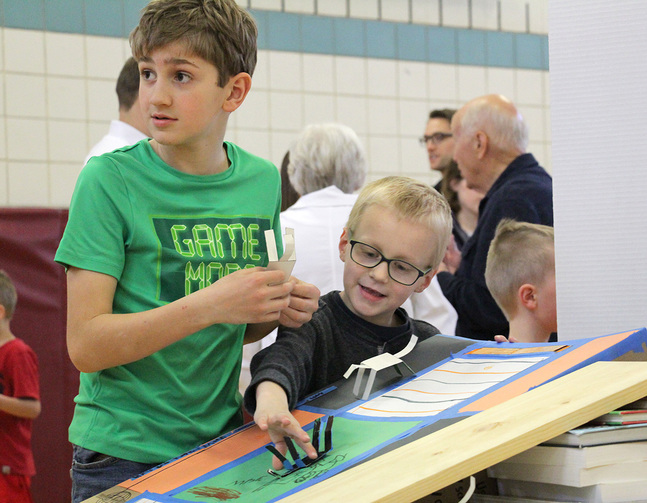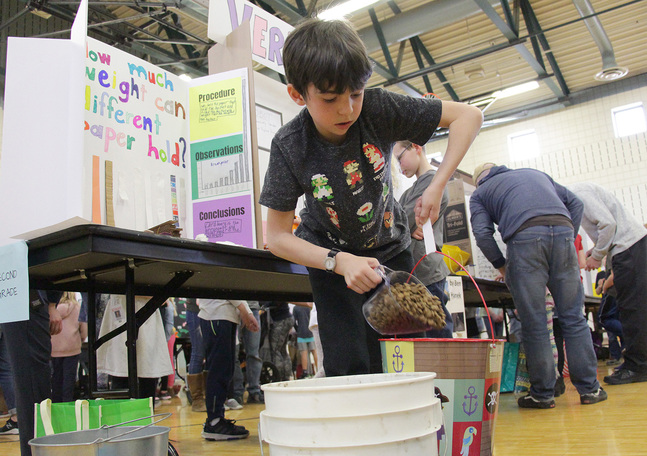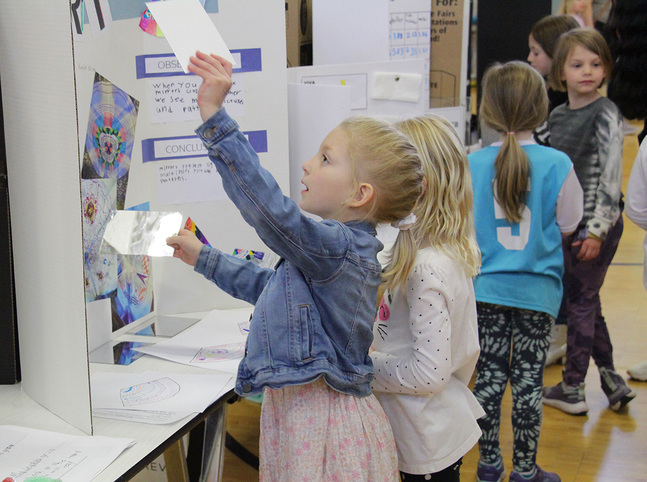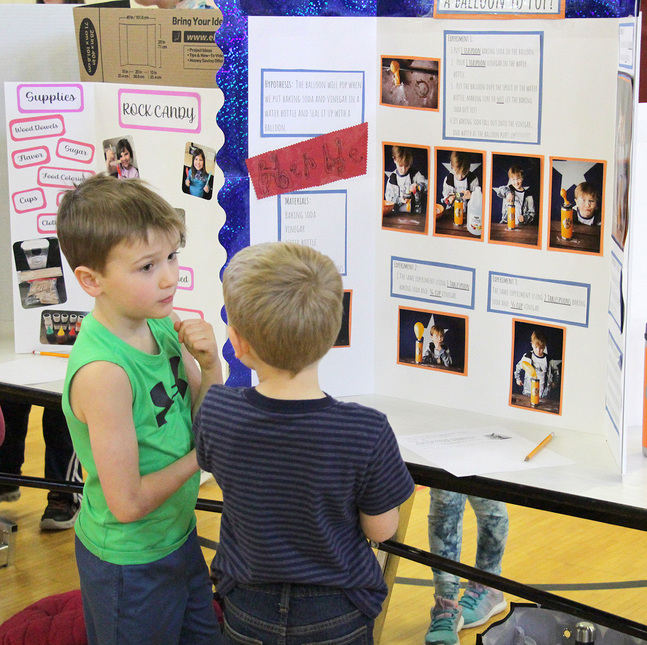Unlimited exploration at Imagination Fair
Posted on: May 26, 2022
Around 90 erudite scientists, engineers, mathematicians and more shared their knowledge with the world during the Delano Elementary School Imagination Fair on Thursday, April 21.
The young scholars explored important questions like which pants are the fastest at the park, what types of milk make the best tie-dye swirl, how to keep sliced apples from browning, and whether ooze is best classified as a liquid or a solid.
There were also nature-based explorations of subjects like currents, bird counts, hurricanes, ocean zones, the life cycle of a frog, and the causes of extinction in wildlife.
Demonstrations explored whether various items would float or sink, how much weight different kinds of paper could hold, and whether baking soda and vinegar could cause a balloon to pop.
Several students took time to share about their projects with the Tiger Cub News during the fair. Read on for their insights.
Jake Hunt
In case one ever has to escape from a falling airplane in a hurry, it may be helpful to know that the size of a parachute does matter in determining how fast you descend.
Sixth-grader Jake Hunt uncovered that practical bit of knowledge by constructing several parachutes from trash bags, string and washers, then dropping them from the top of a stairway and timing their fall.
“In the end we figured out that size does matter, because the bigger surface has a lot more air pushing on it. The smaller one, there is less air pushing up, so it goes down faster,” Hunt said.
How did he come up with the idea?
“Windmills gave me the idea. I thought it would be really interesting to do something with air, because air affects things in many ways,” Hunt said.
As it turned out, parachutes were more user-friendly than windmills.
“They seemed more doable and easier to work with. It would be kind of hard to build a ton of windmills,” said Hunt. “And you would have to worry about the wind being too strong and destroying the windmills.”
Mia Risdall
Second-grader Mia Risdall decided to delve into some experimental farming.
“I knew I was going to do something with plants, because our family loves plants. Then it came to me that I should water them with three different liquids and see which one made the plants grow best,” she said.
She planted green bean seeds in three different pots. She then treated one seed to a drink of water, another to a dousing of milk and a third to pop. The results were partially as expected, but also included a surprise.
“I didn’t think pop would work because it’s filled with sugar and is very fizzy,” Risdall said. “I did think that milk would work, but apparently it rotted,” Risdall said. “I didn’t think about milk being rotten. If it’s rotten it doesn’t work. So those two didn’t grow at all.”
She did end up with one healthy green bean plant nourished by water.
“It was really fun. I liked seeing the water one grow,” she said.
Lincoln Gaalswyk
Second-grader Lincoln Gaalswyk took the opportunity provided by the fair to expand his knowledge of natural disasters.
“I really like learning about natural disasters,” he said. “I read some books so I know a little bit about some of the other things, like tornadoes and tsunamis and stuff, but not really hurricanes. So I wanted to learn more about hurricanes.”
He searched for articles and watched videos online to gather information, then put together a display explaining how hurricanes form, where they are most common, why they can’t survive over land, and more. The exhibit came alive with a fan causing the poster-board’s banner to flutter in the wind, and a “hurricane in a jar” demonstration that Gaalswyk saw online and repeated for fair-goers.
“I tried it once and I thought it looked really cool. So I said I would do it three times today, but I’ve already done it four times,” he said.
So with his expanded knowledge of natural disasters, which one does he find most interesting?
“Probably hurricanes because they’re the most dangerous, I think,” Gaalswyk said. “They are way bigger than I thought they were. The biggest one was as big as half of the United States, so I thought that was really interesting.”
Cale Nester
Cale Nester, a third-grader, explored what baseballs are made of at different levels of play, from T-ball to the major leagues. How did he come up with that idea?
“I signed up for the fair. When I got home the next day I was looking for ideas in my room,” said Nester. “And then I looked outside and I saw this baseball laying on the ground. I thought, ‘That would be cool! There’s an idea.’”
Nester gathered a soft T-ball, a little league ball and a major league-level ball and cut them open to examine their construction.
“The best part was cutting them open,” he said. “When we cut the (major league) one in half it was really hard because it had this core, and it had a ton of thread.”
Overall, Nester said that baseballs made for higher levels of play were made of harder materials, and that preparing for the project was a good experience.
“It was a pretty random idea,” he said. “It just goes to show that things can be random, and they can turn out to be exciting.”
Emma Janzen
Second-grader Emma Janzen decided to explore whether the brand-name Lucky Charms cereal or the generic Marshmallow Mateys cereal were a better value.
“My dad thought of it because we were eating lucky charms a lot,” Janzen said. “We took a picture of the cost of each, and then we divided the price by the weight.”
It turned out the generic brand was two cents cheaper per ounce, but that only tells part of the story. Which one tastes better?
“I like the Marshmallow Mateys better,” said Janzen. “It was a lot of fun. The best part was probably doing the math and dividing it.”
Nick Iwanczuk
Second-grader Nick Iwanczuk created a popular demonstration that tested the strength of various types of paper products, from tissue paper to cardboard.
“I didn’t know what to do so I looked up some ideas on Google and saw a balance one. That gave me the idea of weight,” said Iwanczuk. “Then I saw a bunch of paper in our house so I go the idea of how much weight can different paper hold.”
To do the tests, he brought buckets, various weights, a scale and a calculator. He filled the buckets with weights while suspending them from one type of paper or another to see at what weight the paper broke. He then crunched the numbers with a calculator to rank the papers from weakest to strongest.
What was his favorite part of the experience?
“Mostly when I’m just testing things,” Iwanczuk said. “It just feels good to do it. You’re doing experiments, basically.”
Post Categories: Elementary School



